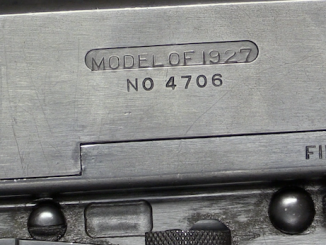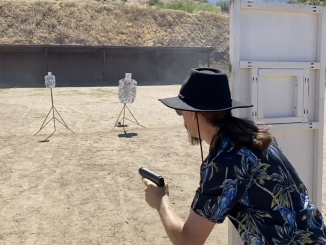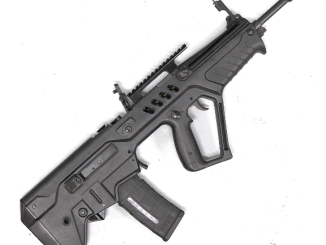In the world of converted semiautomatic “machine guns,” the Browning 1919 is a happy example of one of the most iconic and historically important US machine guns and also one of the cheapest semiautomatic belt fed guns available. This stems from two factors, primarily. One is that the Browning 1919, being developed from the water-cooled M1917 Browning, is a closed bolt system. Open bolt semiautomatic designs are not allowed by ATF, and so most semiauto machine gun conversions require substantial alteration to convert from open bolt to closed bolt – which the M1919 does not need. Second, the IDF used the Browning M1919 for many years and in large numbers, and surplussed many of them in the late 1990s. These guns came into the United States as parts kits in large numbers. This meant a glut of cheap guns, easily built as semi autos, and in an easily shootable caliber – 7.62mm NATO (as converted by Israel from their original .30-06 chambering).
Today, we are looking at an example of a semiautomatic converted M1919, and specifically at the various changes made by Israel to both improve the design and convert it successfully to the NATO cartridge.




Oh good, no need to worry about politics. I wonder if barrel headspace is still a pain on this gun (and if shot timing isn’t applicable anymore).
“wonder if barrel headspace is still a pain on this gun”
Considering that recently upgrade for M2 Browning (.50″) which make it no longer require head-space or timing adjustment from user:
https://www.army.mil/article/92130/m2a1_machine_gun_features_greater_safety_heightened_lethality
it might be possible to create similar solution for 1919 (which will give A7 iteration if I am not mistaken), question is if it would be economic feasible to produce such kit for individual user? And is such upgrade reversible (that is can be M2A1 converted back to M2 standard)?
I would however how would comparison between M2A1 and Vickers .50 ends, in 1920s Royal Navy M1924 (predecessor of M2) against .50 Vickers, which is described in
The British Guns and the Browning Tests chapter here:
http://www.quarryhs.co.uk/Vickers.html
with Vickers found superior
Canada also converted Browning Model 1919 MGs to fire 7.62 X 51mm NATO ammo …… circa 1960 when we adopted the FN rifle in the same calibre.
Internally, Canadaian barrels still have the shallow, rounded grooves to adjust headspace.
Externally, Canadian conversions are easily identified by the huge, oval (race track) cocking handles. Those cocking handles are big enough for Arctic mittens!
I doubt if any Canadian conversions were surplused to civilians.
The parts were, but not a parts kit. Also the South African Army had a 7.62 conversion as well
With Long branch armory closing in mid 70s and Diemaco’s capacity to make new barrels (with brand new Austrian made hammer-forge)in early 80s there was nobody who would perform this conversion.
Also in 1960s they were heavily involved with production of C1 and C2 rifles. So there was no free capacity for another barrel making.
The US Navy converted 1919’s to 7.62 NATO.
The Mk 21 was 7.62mm NATO, the US Navy used it.
It’s a shame this gun does not have the bolt hold open arm. I assume this could be used as a safety. Apart from that, does the M1919 have a safety? The trigger always seems rather exposed to me, I wonder if it caused any problems?
“bolt hold open arm”
There exist page collecting knowledge about M1919, it has even article about that part, which is called bolt latch:
http://www.m1919tech.com/23018.html
“shame this gun does not have”
Honestly, I think in this case it is unnecessary, I doubt in possibility of firing enough number of cartridges in small enough time to cause cook-off (firing of cartridge without user will).
Daewo:
I was not thinking of the risk of a cook-off, more that, as far as I know, the M1919 has no other form of safety. Given that the trigger does not even have a guard, I wonder if this caused problems in service?
” I wonder if this caused problems in service?”
Apparently M37 which replaced M1919 as tank machine gun has safety, according to:
http://browningmgs.com/M37.htm
There is a horizontal trigger safety….
Daweo:
That’s an interesting article.
I wonder if the addition of a safety to the M37 was as an improvement to the M1919. I can’t help thinking that the lack of a safety and a trigger guard on that weapon must have led to accidental discharges.
“must have led to accidental discharges.”
Maybe, however if it was not introduced, despite introducing new marks… wait, no marks but As, then it apparently was not considered great issue.
I think, it is worth to examine Swedish license-production in that regard, I don’t know if it has safety or not.
Ian’s talent for explaining things in entertaining way shows – and he never repeats himself 🙂
Among others, Canada received Br.1919A4s which they rebuilt to suite C21 (Cdn version of M80) in mid 80s. I do not recall all the details but not all changes shown on this gun were implemented as some others were. The method of head space adjustment was kept as original, among other things.
Every time I look at this gun it strikes me how ‘voluminous’ the receiver is (due to trigger frame). Compare German MG34 and MG42 – huge progress in just 2 decades; yet all are recoil operated.
“Compare German MG34 and MG42 – huge progress in just 2 decades; yet all are recoil operated.”
MG 34 was spawned by 31 M light machine gun: https://modernfirearms.net/en/machineguns/switzerland-machineguns/steyr-solothurn-mg-30-eng/
which due to nature of its use should be optimized to give mass as small of possible.
M1919 on the other hand was spawned from M1917 water-cooled machine gun, category of weapon where big mass is acceptable.
“how ‘voluminous’ the receiver is”
Apparently despite this, 1930s U.S. tank designer were very enthusiastic about arming AFV with a lot of machine guns. Notice space inside 1930s AFV was generally were limited*, but nonetheless following vehicles (it is not complete list) were armed with Browning .30″ machine guns:
M2A4 Light Tank was armed with 5 (five) machine guns – 1 in left sponson, 1 in right sponson, 1 in glacis, 1 co-ax with main gun, 1 AA – for comparison Panzerkampfwagen II Ausf. D has only 1 MG 34
M2 Medium Tank was armed with 9 (nine) machine guns – 1 in left forward sponson, 1 in left backward sponson, 1 in right backward sponson, 1 in right forward sponson, 2 in glacis, 1 co-ax with main gun, 2 AA – for comparison early Panzerkampfwagen III have 3 MG 34
* – generally less space to close with armour will mean lighter mass for fixed thickness or bigger thickness for fixed mass of it.
Next, U.S. developed tank machine gun, namely GUN, MACHINE, CAL .30, M37:
http://browningmgs.com/M37.htm
also has receiver of rather big dimensions, however unlike M1919 it can be configured either to feed belt from left or right side.
M37 was produced in 1950s, it was used as armament of 90mm Gun Tank M48 and 105mm Gun Tank M60
M73 on the other hand, was specially designed to take very little space:
https://modernfirearms.net/en/machineguns/u-s-a-machineguns/m73-m219-eng/
although development of what will become M37 and M73 started in similar time, second proved be much more troublesome both in development, M37 designation was assigned in 1959, apparently changes due development were so big that it justified new designation – namely M219 (1972), which despite long development do not worked reliably.
I looked at the pages you provided; what I see there is “mickey-mouse” compared to what I saw on Czech T54-55 tanks. Those were solid and reliable Goryunov guns in tank version.
http://forum.valka.cz/topic/view/17251/SOV-SG-43-SGM-SGMT
They were license produced in CSSR.
“solid and reliable Goryunov guns in tank version.”
Also, it were more space efficient in terms of length, with accordance to data from Modern firearms:
M73 has 559 mm long barrel and 959 mm overall length, that is 58.3% of overall length is for barrel
SGM has 720 mm long barrel and 1150 mm overall length, that is 62.6% of overall length is for barrel
As side note SGM was probably inspiration for designer of Vector SS-77 universal machine gun (South Africa) https://modernfirearms.net/en/machineguns/south-africa-machineguns/vector-ss-77-i-mini-ss-eng/
although considerable lighter it shares method of locking with SGM.
SGM spawned universal machine gun, namely KGK:
https://modernfirearms.net/en/machineguns/hungary-machineguns/kgk-eng/
used in Hungary, until replaced by PK
Regarding SS77 GPMG (recently sold somewhere in Central Asia)is apparently remarkable product. For its origin are credited several guns but AFAIR SG43 is not among them. They usually quote Chinese type67 GPMG, MAG58 (for feed) and a Czech MG (cannot get the type right now).
“SS77 GPMG(…)AFAIR SG43 is not among them”
Please, take close look at how it is locked:
breech block swinging sideways to lock into the receiver wall.
“Chinese type67 GPMG”
This itself has some inspiration from SGM (barrel change mechanism).
Anyway SGMT was replaced with PKT: http://www.militarymodelling.com/news/article/russian-pkt-machine-gun/24508
which is tank version of PK, which beyond typical alterations for tank usage (solenoid trigger) has only heavier barrel.
is: “(…)only(…)”
should be: “(…)also(…)”
PKT was later upgraded and become PKTM: http://www.zid.ru/eng/products/47/detail/225
That is (are) informative page(s) and I appreciate, yet again your research work!
I can tell you something which will be an eye-opener of kind. I had talk (something like 20 years ago) with a man who was in past working in Rock Island arsenal. He told me about “panic” which gripped U.S. tank command about lack of suitable tank co-axial machinegun in 1979s – right in middle of 1.st Cold war.
They just could not use .30cal Browning for various reasons, one of which was inability to ABC seal-off internal tank compartment. Then Mag58 was suddenly found as a life-wheel and quickly adopted. Subsequently, the FNMI in S.Carolina plant was set up to license produce it along with other variants. Rest of story is well known. It was a coup for FN – big time.
“…in 1979s”
was meant to be 1970s….
“Mag58 was suddenly found as a life-wheel and quickly adopted”
The story of M85: https://tankandafvnews.com/2015/08/11/from-the-vault-m85-50-caliber-machine-gun/ which was supposed to replace M2 Browning ended even more interestingly: it was replaced by M2 Browning (weapon which was supposed to replace).
“Mag58 was suddenly found as a life-wheel and quickly adopted”
Interestingly, Sweden still use Ksp m/39 – that is their license produced tank variant of M1919 machine guns as armament for their Stridsfordon 90:
https://en.wikipedia.org/wiki/Combat_Vehicle_90
I guess Swedes did not bother with ABS requirement. Their CV90 is outdated anyway.
Got carried away with brakes….it is meant A(nuclear) B(biological) and C(chemical) type of warfare. No one with brain between their ears wants to come even close to it (late Novichok affair is apparently an aberration).
The Rock Island web site lists this piece as 30-06 Springfield
Pretty obviously incorrectly.
I remember reading that the USN actually did covert some to 7.62 NATO mostly for riverine forces. not sure how widespread those guns were.